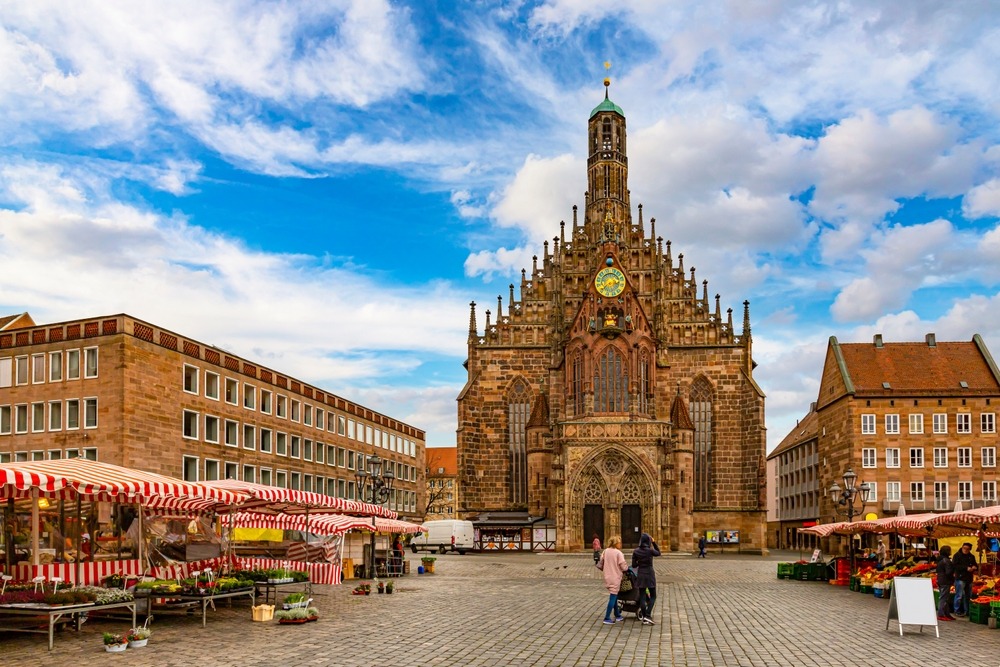Nuremberg, Germany: A City Steeped in History and Vibrant Culture
History of Nuremberg
Nestled in the heart of Bavaria along the banks of the Main River, Nuremberg (Nürnberg in German) is a city whose story spans more than a millennium. First mentioned in historical records in 1050 CE, the city quickly grew into a vital center of trade, politics, and culture during the Middle Ages due to its strategic location at the crossroads of important trade routes.
By the 13th century, Nuremberg had become a Free Imperial City under the Holy Roman Empire, allowing it to operate with significant autonomy. This status attracted artisans, merchants, and intellectuals, turning the city into a bustling hub of innovation and craftsmanship. Its medieval Old Town flourished with the construction of the mighty city walls and the Nuremberg Castle, which served as a residence for various emperors of the Holy Roman Empire.
The city was also a cultural and scientific beacon. In the 15th and 16th centuries, Nuremberg was home to Albrecht Dürer, one of the Renaissance’s most influential artists, and the location where early globe-maker Martin Behaim created the world’s oldest surviving globe. During this time, the city also played a vital role in publishing and scientific discourse.
However, Nuremberg’s history is marked by a darker chapter in the 20th century. The city became closely associated with the Nazi regime, hosting large-scale propaganda rallies at the Nazi Party Rally Grounds. After World War II, it was also the site of the Nuremberg Trials, where leading Nazi officials were brought to justice for war crimes, setting important precedents in international law.
Post-war reconstruction focused on restoring the city’s historic buildings, and today Nuremberg stands as a symbol of resilience, with a cityscape that gracefully combines medieval charm and modern vibrancy.

Top 25 Attractions in Nuremberg
-
Nuremberg Castle (Kaiserburg)
One of the most important imperial castles of the Holy Roman Empire, this majestic fortress offers panoramic views of the city and a glimpse into Nuremberg’s medieval power. -
Albrecht Dürer’s House
This restored half-timbered home of the famous Renaissance artist now serves as a museum showcasing his life, works, and the tools of his trade. -
Nuremberg Old Town (Altstadt)
Encircled by ancient walls, the Altstadt features cobbled streets, historic buildings, bustling markets, and traditional Franconian charm. -
Documentation Center Nazi Party Rally Grounds
A sobering museum that examines the rise of the Nazi Party, located at the actual rally grounds used during the regime’s reign. -
Nuremberg Trials Courthouse (Courtroom 600)
The courtroom where the historic post-WWII trials were held. A museum provides insight into international law and justice. -
St. Lorenz Church (Lorenzkirche)
A stunning example of Gothic architecture, this 13th-century church is renowned for its intricate façade and treasured artworks. -
St. Sebaldus Church (Sebalduskirche)
Dedicated to Nuremberg’s patron saint, this Romanesque and Gothic hybrid church features beautiful stained glass and a bronze shrine. -
Germanisches Nationalmuseum
Germany’s largest museum of cultural history houses an impressive collection ranging from prehistoric artifacts to contemporary art. -
Nuremberg Zoo (Tiergarten Nürnberg)
One of Europe’s most beautiful zoos, it spans a large wooded area and includes exotic animals, an aquarium, and dolphin shows. -
Nuremberg Christmas Market (Christkindlesmarkt)
Held in Hauptmarkt square, this is one of the oldest and most famous Christmas markets in the world, known for gingerbread and hand-crafted gifts. -
Toy Museum (Spielzeugmuseum)
Celebrating Nuremberg’s legacy as a toy-making hub, this museum displays toys from antiquity to modern times, delighting all ages. -
Weißgerbergasse (Tanners’ Lane)
A picturesque street lined with colorful medieval houses, offering a walk through time and a perfect photo opportunity. -
Nuremberg Transport Museum (Verkehrsmuseum)
Featuring historical locomotives and railway technology, this museum also includes a model railway and interactive exhibits. -
Hauptmarkt Square
The central market square hosts daily vendors, seasonal festivals, and is home to the ornate Schöner Brunnen (“Beautiful Fountain”). -
Schöner Brunnen
A 14th-century Gothic fountain with 40 intricately carved figures representing the world view of the Holy Roman Empire. -
Handwerkerhof (Craftsmen’s Courtyard)
Located by the Königstor gate, this quaint artisan village within the old city walls showcases traditional crafts and souvenirs. -
City Walls and Towers
Walk along the remnants of Nuremberg’s 5-kilometer medieval walls and towers for sweeping views and historic ambiance. -
Museum Tucherschloss und Hirsvogelsaal
This Renaissance-era patrician residence offers insight into Nuremberg’s wealthy merchant class and their lavish lifestyles. -
Felsengänge (Underground Rock Cellars)
Tour the maze-like sandstone cellars beneath the city, historically used for beer storage and as bomb shelters during WWII. -
Neues Museum Nürnberg
A sleek, contemporary art museum contrasting with the city’s historic architecture, featuring modern visual arts and design. -
Ehekarussell (Marriage Carousel Fountain)
A dramatic and whimsical sculpture fountain illustrating the stages of marriage, based on a poem by Hans Sachs. -
Memorium Nuremberg Trials
An extension of the courtroom museum offering in-depth exhibits and multimedia presentations on the trials and their legacy. -
Museum of Industrial Culture (Museum Industriekultur)
Located in a former factory, this museum tells the story of Nuremberg’s industrial growth through machines, cars, and local stories. -
Zeppelinfeld
Part of the Nazi rally grounds, this massive field and grandstand offers haunting insight into propaganda architecture and history. -
Frauentor and Königstor
Two iconic medieval city gates that once guarded Nuremberg’s main entrances and now frame the vibrant Handwerkerhof.

Nuremberg is a city where history breathes through every street, building, and monument. From its golden age as a medieval powerhouse to its pivotal role in 20th-century history, the city offers a captivating journey through time. Whether you’re exploring imperial castles, wandering through toy museums, or contemplating the lessons of the past at the rally grounds, Nuremberg presents a travel experience rich in culture, education, and unforgettable sights.

































